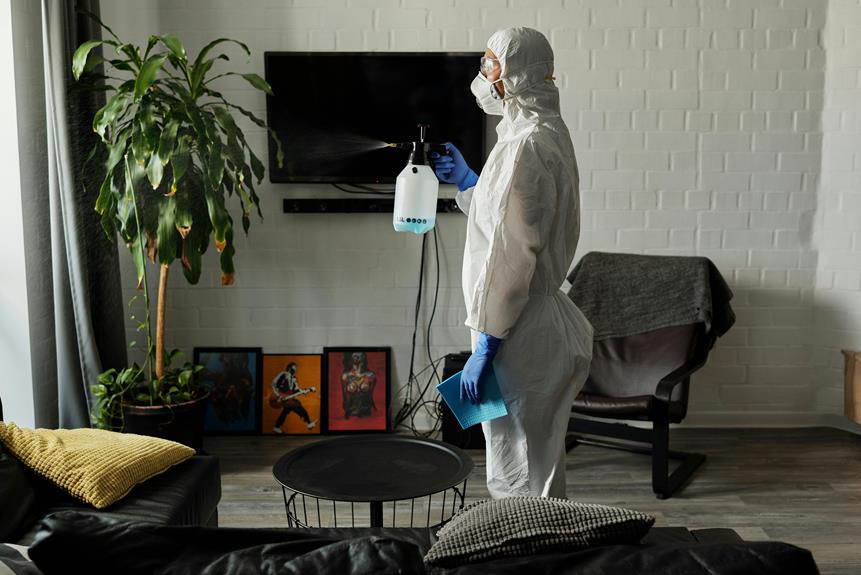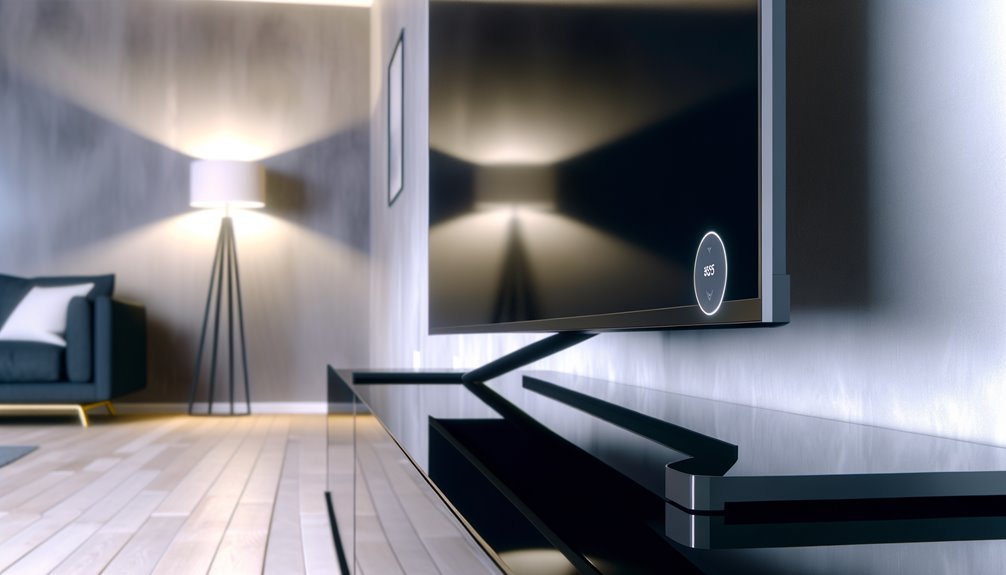Almost all modern TVs can be mounted, but you’ll need to check a few things first. Guarantee your TV is VESA compatible by looking for a standard screw pattern and threaded holes on the back. Measure your TV’s size and weight, then match these specs with a suitable wall mount. Verify that your TV and mount share the same mounting hole patterns. Consider the type of wall you have and select appropriate mounting hardware. Confirm the TV input ports are accessible post-mounting. For a secure installation and to avoid potential pitfalls, there’s more you might want to know.
Key Information
- TVs with VESA-compatible mounting holes can be securely mounted.
- Verify TV’s weight and size match the wall mount’s capacity.
- Different TV brands and models have unique mounting hole patterns.
- Ensure wall material can support the TV’s weight for secure installation.
- Check TV’s input ports for easy access after mounting.
VESA Compatibility
When considering TV mounting, it’s important to verify your TV’s VESA compatibility to guarantee a secure and stable installation. VESA sets a standard screw pattern for TV mounts, making it easier to find a compatible mount.
To verify your TV’s VESA pattern, look for four threaded holes on the back of your TV arranged in a universal pattern. Most modern flat panel TVs adhere to this standard. If you’re using a non-manufacturer mount, ensuring it matches your TV’s VESA size is essential for proper alignment and stability.
This step helps avoid any potential mishaps and ensures your TV is securely mounted. Always double-check the VESA specifications in your TV’s manual or product details before proceeding.
TV Size and Weight
After confirming your TV’s VESA compatibility, the next step is to make sure the wall mount can support the TV’s size and weight.
Begin by measuring your TV diagonally to determine its size. Larger TVs tend to be heavier, which impacts the type of wall mount you’ll need.
Check the weight of your TV and verify it aligns with the weight capacity specified by the wall mount manufacturer. Matching your TV’s weight and dimensions with the correct wall mount is crucial for a secure installation.
Failing to do so could result in the mount failing, potentially damaging your TV and wall. Always double-check both the TV’s weight and the mount’s load-bearing specifications to guarantee a safe fit.
Mounting Hole Patterns
Confirming that your TV’s mounting hole pattern matches the wall mount is essential for a secure installation. TVs have specific mounting hole patterns on the back, known as VESA (Video Electronics Standards Association) patterns. These patterns must align with your wall mount to guarantee compatibility and stability.
Start by verifying your TV’s VESA compatibility, typically listed in the user manual or on the manufacturer’s website. Different TV brands and models have unique hole patterns, so double-check your TV’s specifications. Most mounts list the VESA standards they support, making it easier to match them with your TV.
Wall Types and Materials
Understanding the characteristics of different wall types like drywall, brick, concrete, and plaster is essential for selecting the right mounting techniques and hardware for your TV.
Drywall often requires anchors to provide adequate support, while mounting on brick or concrete needs specialized tools for drilling. Always consider the wall material when picking your mounting hardware to guarantee a secure installation.
It’s important to check the weight capacity of your wall and choose a mount that can support your TV’s weight. If you’re unsure about mounting on specific wall types, consult a professional to ensure safety and stability.
Properly evaluating your wall type and using the appropriate equipment ensures a successful and secure TV installation.
TV Inputs and Ports
Understanding the array of input ports on your TV is crucial for guaranteeing compatibility with all your external devices. Different TVs offer varying options like HDMI, USB, Ethernet, and audio/video inputs. The number and type of these ports directly impact your ability to connect gaming consoles, sound systems, and other peripherals.
Slimmer, newer TVs might’ve fewer ports, necessitating the use of adapters or HDMI switches for multiple devices. With Smart TVs, built-in Wi-Fi and streaming apps might reduce your need for physical ports.
Always check the TV’s input options before mounting it to make sure you have easy access and connectivity for your devices, avoiding future hassles when you need to plug something in.
Hiring a Professional
After verifying your TV’s input options and making sure everything is ready for connection, hiring a professional for the mounting process can save you time and prevent potential mishaps. Professionals have the tools and experience to securely mount TVs on various wall types, assess wall structures, locate studs, and determine the best placement for best viewing. Their expertise minimizes the risk of damage and often includes warranties or guarantees for added peace of mind.
Here’s a comparison to think about:
| Aspect | DIY Installation | Professional Installation |
|---|---|---|
| Tools Needed | May need to purchase or rent | Professionals bring their own |
| Time Required | Potentially extensive | Typically quicker |
| Risk of Damage | Higher | Substantially lower |
| Peace of Mind | Dependent on skill | Warranties/guarantees often included |
Hiring a pro ensures a smooth, secure, and stress-free TV mounting experience.
Frequently Asked Questions
How Can You Tell if a TV Can Be Mounted?
Double-check your TV’s weight and dimensions, examine the VESA mounting points, and confirm the back panel is flat. Validate that the VESA pattern aligns with the wall mount and inspect the mounting points for secure installation.
Can You Put a TV Mount on Any Tv?
You can’t mount every TV. Verify that your TV has VESA compatibility and a flat back panel. Check the mounting points and weight capacity. Irregular or curved TVs often aren’t suitable for standard mounts, requiring specific solutions.
Are Some TVS Not Mountable?
Yes, some TVs aren’t mountable. If your TV lacks a flat back panel, designated mounting points, or VESA compliance, it may not securely mount. Always check your TV’s design and mounting specifications before attempting installation.
Can All TVS Be Attached to the Wall?
Not all TVs can be attached to the wall. Check if your TV has a flat back, VESA hole pattern, and mounting points. Consult the manual for compatibility with standard VESA sizes and any specific mounting requirements.
Conclusion
So, while most TVs can be mounted, you’ve got to take into account VESA compatibility, size, weight, and mounting hole patterns.
Don’t forget to evaluate your wall’s material and ensure easy access to inputs and ports.
If you’re unsure, hiring a professional can save you time and hassle.
By paying attention to these details, you’ll guarantee a secure and ideal TV mounting experience.
Remember, a well-mounted TV enhances both aesthetics and viewing comfort.



